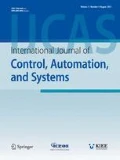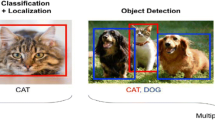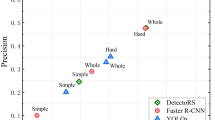Abstract
In this paper, we propose a hierarchical approach for background modeling and moving objects detections in the intelligent visual surveillance system. The proposed approach models the background in block level and pixel level hierarchically, and the background is represented by texture information in block level and by color information in pixel level respectively. Meanwhile the variable parameters learning rate is proposed to speed up the convergence of the model parameters in the pixel model. The proposed approach provides us with many advantages compared to the state-of-the-art. Experimental results demonstrate the effectiveness and efficiency of the proposed approach.
Similar content being viewed by others
References
C. Stauffer and W. Grimson, “Adaptive background mixture models for real-time tracking,” Computer Vision and Pattern Recognition, vol. 2, pp. 246–252, 1999.
A. Elgammal, D. Harwood, and L. S. Davis, “Non-parametric model for background subtraction,” Proc. of European Conference on Computer Vision, pp. 751–767, 2000.
M. Heikkila, M. Pietikainen, and J. Heikkila, “A texture-based method for detecting moving objects,” British Machine Vision Conference, vol. 1, pp. 187–196, 2004.
M. Heikkila and M. Pietikainen, “A texture-based method for modeling the background and detecting moving objects,” IEEE Trans. on Pattern Analysis and Machine Intelligence, vol. 28, no. 4, pp. 657–662, April 2006.
T. Hoprasert, D. Harwood, and L. S. Davis, “A statistical approach for real-time robust background subtraction and shadow detection,” Proc. of International Conference on Computer Vision, pp. 1–19, 1999.
J.-S. Hu and T.-M. Su, “Robust background subtraction with shadow and highlight removal for indoor surveillance,” EURASIP Journal on Advances in Signal Processing, p. 14, 2007.
O. Javed, K. Shafique, and M. Shah, “A hierarchical approach to robust background subtraction using color and gradient information,” IEEE Workshop on Motion and Video Computing, pp. 22–27, 2002.
H. Grabner and H. Bischof, “On-line boosting and vision,” Computer Vision and Pattern Recognition, vol. 1, pp. 260–267, 2006.
D.-S. Lee, “Effective gaussian mixture learning for video background subtraction,” IEEE Trans. on Pattern Analysis and Machine Intelligence, vol. 27, no. 5, pp. 827–832, May, 2005.
J. Yao and J.-M. Odobez, “Multi-Layer background subtraction based on color and texture,” Computer Vision and Pattern Recognition, pp. 1–8, 2007.
K. Kim, T. H. Chalidabhongse, D. Harwood, and L. Davis, “Real-time foreground-background segmentation using codebook model,” Real-Time Imaging, vol. 11, no. 5, pp. 172–185, June 2005.
H. Lee, S. Hong, I. F. Nizami, and E. Kim, “A noise robust gait representation: motion energy image,” International Journal of Control, Automation, and systems, vol. 7, no. 4, pp. 638–643, 2009.
H. C. Cho, M. S. Fadali, and K. S. Lee, “Online probability density estimation of nonstationary random signal using dynamic bayesian networks,” International Journal of Control, Automation, and systems, vol. 6, no. 1, pp. 109–118, 2008.
X. Chen and Y. Li, “On convergence and parameter selection of an improved particle swarm optimization,” International Journal of Control, Automation, and systems, vol. 6, no. 4, pp. 559–570, 2008.
J. Park, Y. Lee, and H. Ko, “Dynamic time warping based identification using gabor feature of adaptive motion model for walking humans,” International Journal of Control, Automation, and systems, vol. 7, no. 7, pp. 817–823, 2009.
Author information
Authors and Affiliations
Corresponding author
Additional information
Recommended by Guest Editor Seong G. Kong. This work was supported by the National Natural Science Foundation of China (Grant No. 60905008, 60833006) and National Basic Research Program (973) of China under contract No. 2010CB 327905.
Jie Yang received his B.E. and M.E. degrees from Tianjin University of Sciences and Technology, China in 2001 and 2004, respectively. Currently, he is a Ph.D. candidate in the National Laboratory of Pattern Recognition, Institute of Automation, Chinese Academy of Sciences. His research interests include computer vision, pattern recognition and machine learning, intelligent video surveillance, video processing, and embedded systems.
Jinqiao Wang received his B.E. degree in 2001 from Hebei University of Technology, China, and his M.S. degree in 2004 from Tianjin University, China. He received his Ph.D. degree from the National Laboratory of Pattern Recognition, Chinese Academy of Sciences in 2008. He is now an Assistant Professor with Chinese Academy of Sciences. His research interests include pattern recognition and machine learning, image and video processing, mobile multimedia and intelligent video surveillance.
Hanqing Lu received his B.E. and M.E. degrees from Harbin Institute of Technology, China, and his Ph.D. degree from Huazhong University of Sciences and Technology, China in 1982, 1985, and 1992, respectively. Currently, he is a Professor of the National Laboratory of Pattern Recognition, Institute of Automation, Chinese Academy of Sciences. His research interests include image and video analysis, medical image processing, and object recognition. He has published more than 100 papers in these fields.
Rights and permissions
About this article
Cite this article
Yang, J., Wang, J. & Lu, H. A hierarchical approach for background modeling and moving objects detection. Int. J. Control Autom. Syst. 8, 940–947 (2010). https://doi.org/10.1007/s12555-010-0502-3
Received:
Accepted:
Published:
Issue Date:
DOI: https://doi.org/10.1007/s12555-010-0502-3




